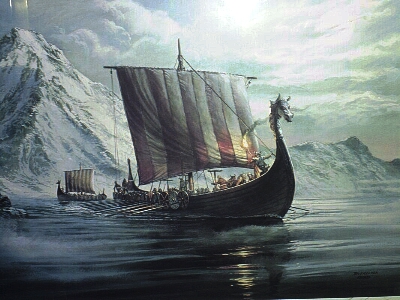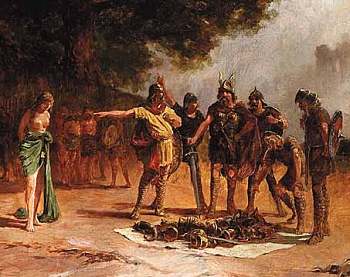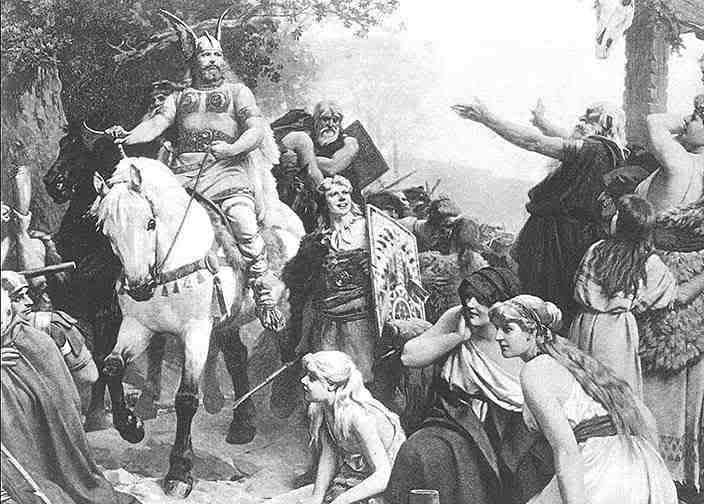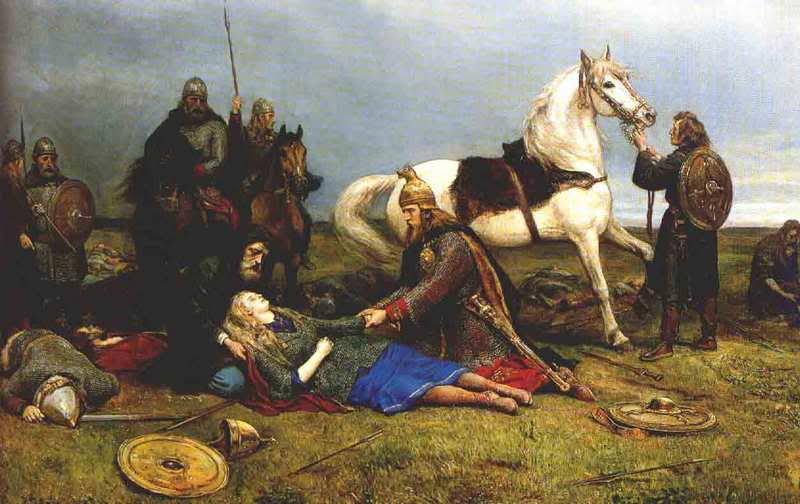Excerpted from the 21st article of William Pierce’s “Who We Are: a Series of Articles on the History of the White Race”:
The Vikings’ fighting spirit had been sapped by Christianity, but an even larger factor in their demise was their inability to keep in check their quarrels among themselves, combine their forces against outsiders, and thus match the growing power of kings in more unified lands than their own. Excessive individualism took its final toll.
Ever since the close of the Viking Age men in whose veins Viking blood still runs have dreamed of the freedom and the challenge and the glory of those bygone days. Perhaps nowhere is this better expressed than in a stanza from an anonymous Anglo-Saxon poem, The Wanderer:
What has become of the steed?
What has become of the warrior?
What has become of the seats of banquet?
Where are the joys of the hall?
Oh, for the bright cup!
Oh, for the mail-clad warrior!
Oh, for the glory of the prince!
How that time has passed away
And grown dark under the cover of night,
As if it had never been.
Semites and Vikings: No Love Lost
One would expect to find a spiritual difference between a race bred a hundred generations in the marketplace, where survival depended primarily on a glib tongue and an eye for a bargain, and a race shaped by the killing winters of the North, accustomed to combat and hardship. This difference—the difference between the Jewish spirit and the White spirit—is manifested in the world around us in a thousand ways.
Perhaps nowhere has the contrast between the natural, healthy, adventurous spirit of our race and the spirit of the Jew been more sharply drawn, however, than in a couple of recent issues of the student newspaper published on the Los Angeles campus of California State College. In the first issue was printed a poem by Dr. Peter Peel, who teaches history there. The second issue contained a response to the poem from a Jew at the same college.
Here is the poem, which was titled Goetterdaemmerung:
When Spring lightly touches
With hand green and golden
The mountains and fjords,
Then shouts the sea rover,
“A-viking! A-viking!”
The hammers are busy
On weapon and harness.
Then flashes the broad blade
In every sea hamlet.
The dragon ships, thirsty
For bounding blue water,
Leap down to the seashore.
And Olaf of Norway
And Erik of Gotland
And Thorwald the Mighty,
Whose grandsire was Wotan,
Stand fast on the poop deck
With golden hair streaming,
With spear brightly glinting,
With eye fierce and blazing,
Sail out on the swan’s bath—
The grey widow-maker—
For England or Iceland,
Byzantium, Vinland,
Far land or ancient
And ripe for the plunder,
The burning of roof-trees,
The seizing of women,
The tooting of treasure,
The flowing of red blood,
And wine for the victors.
Ah, whence fled those great days,
The days of our fathers,
The days of the valiant,
Of gods and of heroes,
Or fair maids and foul dwarfs,
And lindworms and dragons,
Of Beowulf, Dietrich,
Strong Harald, grim Hagen,
Wolfhart and Siegfried,
The greathearts, the mighty?
Yea loathsome today is
The seed of their strong loins—
The petty, the small, the clod and
the crawler.
The music has gone from the souls of our people.
The thunder has vanished away with Valhalla.
Now meekness and weakness
And womanly virtues
Have shackled, degraded
And shamefully softened
The sons of our fathers,
The sons of the mighty.
And now have we traded
The lightning of storm gods,
The arms of Valkyries,
The halls of Valhalla,
The kiss of wish maidens,
For wings and a nightshirt,
A harp and a halo,
A psalmbook and psalter?
Oh, no, my Lord Bishop!
Hark, grey Galilean,
The Wolf Age is coming,
The great fimbul winter,
When all sick things perish.
A few days after this poem appeared, the following letter [by R.A. Klein] headed “Bloodthirsty Sickness,” showed up on the editorial page of the student newspaper. The poem about the Vikings in the Nov. 25 issue by Peter H. Pee had real soul and beauty—the soul and the beauty of the bloodthirsty.
Let it speak for itself. [Klein wrote:]
“With golden hair streaming, With spear brightly glinting, With eye fierce and blazing… And ripe for the plunder, The burning of roof-trees, The seizing of women, The looting of treasure, The flowing of red blood, And wine for the victors.”
Murder! rape! loot, plunder blood and wine—the wanton destruction of the productive by bloodthirsty savages. And what do these vicious predator-warriors denounce?
“Now meekness and weakness And womanly virtues Have shackled, degraded And shamefully softened The sons of our fathers, The sons of the mighty.”
Yes, how could one be more degraded in the eyes of these savages than to become like those inferior creatures called women.
Beware you women, blacks, Latins and other lesser creatures. The Blond Beast “With golden hair streaming” and warm, red blood dripping from his mighty sword shall rise again. Beware you weak and sick of all races for “The Wolf Age is coming… When all sick things perish.”
Meanwhile, I wait for the day when this bloodthirsty sickness of the Blond Beast shall perish forever from the face of the earth.





